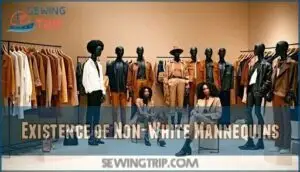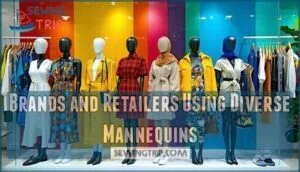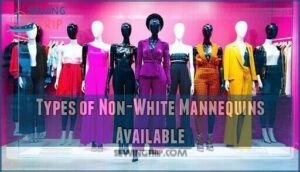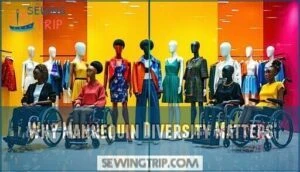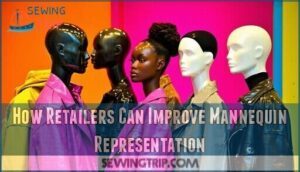This site is supported by our readers. We may earn a commission, at no cost to you, if you purchase through links.
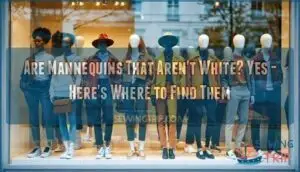 Yes, you can definitely find mannequins that aren’t white.
Yes, you can definitely find mannequins that aren’t white.
While about 85% of store mannequins still display white or light skin tones, major retailers like Target, Nike, Macy’s, and Savage x Fenty are changing the game.
These brands showcase multicultural mannequins representing African American, Latino, Asian, and other diverse backgrounds. Lane Bryant even offers four different skin tones, and Disney specifically requests Latino and Asian models for their displays.
The shift makes sense – diverse shoppers make up nearly 40% of the U.S. population, and studies show multicultural customers respond 22% more positively to inclusive displays.
While production costs and industry traditions have slowed progress, more manufacturers worldwide are creating diverse options. Smart retailers are discovering that representation isn’t just the right thing to do – it’s good business that builds stronger customer connections and brand loyalty.
Table Of Contents
Key Takeaways
- You’ll find non-white mannequins at major retailers – Target, Nike, Macy’s, and Savage x Fenty showcase diverse skin tones representing African American, Latino, and Asian backgrounds, proving these options exist beyond traditional white displays.
- Diverse mannequins boost your shopping experience – Studies show that multicultural customers respond 22% more positively to inclusive displays, and you’re 24% more likely to feel positive about brands that represent various ethnicities.
- Cost isn’t the real barrier – Non-white mannequins don’t cost significantly more than white ones (only about a 5-cent difference), so the main obstacles are industry traditions and retailer hesitation rather than financial concerns.
- You can demand better representation – With nearly 40% of U.S. shoppers being multicultural, retailers are discovering that diverse mannequins aren’t just socially responsible – they’re a smart business that builds stronger customer connections and brand loyalty.
Racial Diversity in Retail Mannequins
You’ve probably noticed something walking through stores: almost every mannequin you see is white, from Target’s featureless forms to high-end boutiques’ sleek displays.
While this might seem normal, it’s actually a choice that affects how welcome different shoppers feel and whether they can imagine themselves in the clothes being sold.
Prevalence of White Mannequins in Stores
Walk into most retail stores today, and you’ll likely notice something striking: the mannequins are overwhelmingly white. Research shows roughly 85% of mannequins display white or light skin tones, creating a landscape that doesn’t reflect our diverse world.
Most store mannequins are white, but our shoppers aren’t—time for displays that reflect reality
- Department stores show less than 8% non-white mannequins despite serving multicultural communities
- Window displays in top U.S. retailers feature over 90% Eurocentric mannequin features
- Urban flagship stores only marginally increase diverse mannequins compared to suburban locations
This prevalence of white mannequins impacts store aesthetics and customer preferences, with studies revealing that diverse mannequins boost positive perception by 22% among multicultural shoppers. The current retail trends show mannequin diversity lagging behind other representation efforts, despite clear diversity impact on racial representation and customer connection.
Industry Traditions and Design Choices
You’ve probably noticed how retail stores stick to familiar patterns when choosing mannequins. The industry’s long-standing preference for white, featureless figures isn’t just about tradition—it’s about playing it safe.
| Design Element | Traditional Choice | Impact on Shoppers | Missed Opportunity |
|---|---|---|---|
| Mannequin Materials | White fiberglass | Feels clinical, distant | Warmer skin tones create connection |
| Color Schemes | Neutral whites/grays | Blends into background | diverse mannequins stand out positively |
| Aesthetic Choices | Faceless, generic | One-size-fits-all approach | ethnic dolls reflect real customers |
| Design Trends | Cookie-cutter sameness | Reinforces exclusion | black mannequins show clothing beautifully |
Retailers often cite Production Costs as justification, claiming non white models cost more. But that’s changing as demand grows for mannequin diversity in forward-thinking stores.
Visual Impact on Store Displays
The visual impact on store displays depends heavily on color schemes and display lighting.
When you see all-white mannequins in window displays, they create a specific aesthetic that affects how you perceive the clothing.
These stark white forms can wash out darker fabrics under certain lighting, making black mannequins or diverse models a smarter choice for visual merchandising.
Store layouts featuring inclusive fashion with ethnic dolls and non white models create more dynamic, engaging displays that better showcase how garments actually look on different skin tones, which is a key aspect of visual merchandising.
Are There Mannequins That Aren’t White?
You’ll find that non-white mannequins absolutely exist, though they’re still less common than their white counterparts in most retail spaces.
Major brands like Adidas, Macy’s, and several other retailers have started featuring mannequins with Black, Asian, and Latinx skin tones since around 2017.
Existence of Non-White Mannequins
Yes, non-white mannequins absolutely exist! You’ll find diverse models with various skin tones representing African American, Latino, Asian, and other multicultural backgrounds.
These ethnic models aren’t just wishful thinking—they’re real products available from manufacturers worldwide. Mannequin diversity has expanded beyond traditional options, offering cultural representation that reflects actual customers.
The question isn’t whether they exist, but where retailers choose to display them. Retailers can enhance their store displays with diverse mannequins to better represent their customer base.
Brands and Retailers Using Diverse Mannequins
You’ll find diverse fashion models at major retailers embracing brand inclusivity.
Target, Nike, and Old Navy showcase multicultural models in their displays, while Lane Bryant features African American models across four skin tones.
Savage x Fenty’s ethnic displays celebrate all backgrounds, and Disney requests Latino dolls and Asian models.
These mannequin trends reflect inclusive retail’s growing momentum.
The use of diverse models promotes sports fashion diversity and contributes to a more welcoming shopping environment with diversity.
Types of Non-White Mannequins Available
Looking beyond traditional white displays, you’ll discover Black mannequins with rich skin tones, Asian figures showcasing diverse features, and Latinx models representing various ethnicities.
Dark skinned mannequins bring authenticity to ethnic displays, while multicultural models reflect real customers.
These diverse fashion models—from African American models to Latino dolls—help everyone see themselves represented in stores.
The use of various dress styles, including those with different types of dress silhouettes, can enhance the authenticity of these mannequin displays, promoting a sense of inclusivity.
Why Mannequin Diversity Matters
You’ve probably noticed that most mannequins look like they stepped out of the same mold – and that mold is overwhelmingly white.
But here’s the thing: when stores use diverse mannequins that actually reflect their customers, something pretty amazing happens for both shoppers and business.
Reflecting Real-World Populations
How can retail stores better mirror their actual customers? Today’s mannequins are catching up to reality, showing the demographic accuracy that’s been missing for decades.
Here’s what you’ll see in forward-thinking stores:
- Hispanic mannequins and indigenous models reflecting local populations
- Middle eastern models and disabled mannequins breaking traditional barriers
- Ethnic variety with cultural sensitivity that matches community diversity metrics
This population reflection isn’t just trendy—it’s smart business that welcomes everyone through your doors. When creating inclusive displays, considering a professional dress form can help retailers achieve accurate representations of their target audience.
Challenging Stereotypes and Bias
When all-white mannequins dominate store displays, you’re witnessing outdated beauty standards in action.
These homogeneous figures perpetuate the myth that whiteness equals "normal" or "universal."
Diverse mannequins featuring hispanic mannequins, indigenous models, middle eastern models, and disabled mannequins challenge these narrow perspectives.
They promote bias awareness and cultural sensitivity, proving that ethnic inclusion isn’t just trendy—it’s necessary for racial equity and social justice in retail spaces.
Promoting Inclusivity and Representation
When you embrace Diverse Displays and Inclusive Marketing, you’re creating space where everyone belongs.
Cultural Sensitivity matters because customers want to see themselves reflected, not erased.
Body Positivity through plus size models and realistic dolls shows authenticity, and Southeast asian dolls and body positive dolls demonstrate genuine Ethnic Awareness, proving Diversity and Representation aren’t just buzzwords—they’re business sense.
Effects on Customer Perception and Brand Loyalty
Studies show that diversity in retail displays creates real impact on your shopping experience.
Diverse mannequins make customers feel seen and boost brand loyalty by 24%
When you see mannequins reflecting various ethnicities like Southeast Asian dolls or body positive dolls, you’re 24% more likely to feel positive about that brand.
This enhanced shopper engagement translates into stronger customer loyalty and improved brand identity, proving diversity and representation aren’t just nice-to-haves—they’re smart business moves that reshape consumer perception entirely.
Challenges to Increasing Mannequin Diversity
While many retailers want diverse representation, several roadblocks make it challenging to move beyond white mannequins.
You’ll find that everything from production costs to industry traditions creates barriers that keep store displays looking surprisingly uniform.
Retailer Demand and Industry Practices
While many fashion retailers cling to traditional all-white displays, you’ll find the industry slowly shifting.
Here’s what’s driving current retailer demand:
- Market Research shows diverse shoppers want representation
- Industry Standards still favor white mannequins by default
- Retail Strategies increasingly include diversity initiatives
- Mannequin Trends reflect growing cultural awareness
- Manufacturing Costs remain similar across skin tones
Most clothing stores haven’t caught up with their customers’ expectations yet.
Production and Cost Considerations
Producing diverse mannequins isn’t just about good intentions—it’s about the bottom line. Manufacturing costs vary substantially based on customization needs and production scale.
When considering the production of diverse mannequins, manufacturers must also think about the best material options to guarantee durability and quality.
| Cost Factor | Standard White | Diverse Options |
|---|---|---|
| Base Material Costs | $16-150 per unit | Same range |
| Custom Finishing | Minimal | Hand-painted details add labor time |
| Development Fees | Standard molds | $12,000-15,000 for new designs |
Supply chains face challenges with specialized paints and skilled labor for realistic mannequins. While material costs remain similar, the manufacturing process for body positive dolls requires artisan craftsmanship.
Bulk orders reduce mannequin pricing, but smaller retailers often pay premium rates for diverse adult mannequins and child mannequins.
Concerns Over Misrepresentation
You’ll face pushback when stores worry about getting diversity "wrong."
Some retailers fear that realistic mannequins might reinforce racial stereotypes or create ethnic bias through poor color impact choices. Others dodge cultural sensitivity concerns by sticking with traditional white adult mannequins and child mannequins.
However, these fears often mask deeper resistance to change. Diversity matters – imperfect inclusion beats perfect exclusion.
When creating diverse mannequins, considering a custom dress form can help achieve accurate body representations. Body positive dolls and diverse mannequin styles prove that authentic representation matters more than perfection.
Advocacy and Resistance to Change
Grassroots activists and social justice advocates are pushing retailers to embrace diversity in their mannequins, but they’re hitting walls.
You’ll find resistance tactics like delayed responses, minimal changes, and quick reversions to all-white displays.
The fashion industry’s change management often prioritizes tradition over inclusion strategies, making diversity advocacy feel like an uphill battle against entrenched marketing practices.
How Retailers Can Improve Mannequin Representation
You don’t have to stick with all-white displays just because that’s how things have always been done.
Smart retailers are already discovering that diverse mannequins aren’t just the right thing to do—they’re also good for business.
Collaborating With Diverse Mannequin Manufacturers
Building bridges with the right suppliers opens doors to authentic representation.
Major manufacturers like Greneker and Mannequin by HOL offer extensive diverse collections featuring various skin tones and ethnicities.
You’ll find fiberglass mannequins reflecting Black, Latinx, and Asian features through strategic manufacturer partnerships.
These suppliers collaborate on inclusive design projects, helping retailers meet diversity standards while creating meaningful retail displays that welcome all customers.
Retailers can also explore online marketplaces for diverse mannequin options to enhance their store displays, promoting a sense of diverse collections and meaningful retail displays that highlight inclusive design.
Customization for Skin Tones and Body Types
Three key customization areas can transform your store’s representation.
You’ll find mannequins with varied skin tone options, from deep ebony to warm caramel shades.
Plus size models and diverse body type variations help customers see themselves reflected in your displays.
- Skin Tone Options: Choose fiberglass mannequins in bronze, mahogany, or olive tones that match your community’s demographics
- Body Type Variations: Select plastic mannequins with different mannequin proportions – curvy, athletic, or petite frames beyond standard sizing
- Ethnic Facial Features: Incorporate dress forms and mannequin parts with authentic nose shapes, lip fullness, and bone structure representing various ethnicities
To create a more personalized shopping experience, understanding how to make your own dress form can be highly beneficial for retailers.
Inclusive Store Display Strategies
Once you’ve customized your mannequins, you’ll need smart Storefront and Window Display strategies.
Mix different skin tones throughout your fashion displays rather than clustering them. Rotate your storefront mannequins regularly so customers see varied representation each visit.
Position diverse mannequins in high-traffic areas and eye-catching window spots. This approach to Retail Display and Merchandising naturally boosts Customer Engagement while strengthening your Store Aesthetics and Retail Inclusion efforts.
By incorporating diverse mannequin options, retailers can effectively promote diversity and inclusivity in their store displays.
Measuring Impact on Customers and Business
When you’re ready to measure your diverse mannequins’ success, track these key business outcomes that matter most:
- Customer Engagement – Monitor how long shoppers spend in your storefront and which displays draw the most attention
- Sales Impact – Compare revenue before and after adding diverse mannequins to your retail displays
- Brand Perception – Survey customers about how inclusive marketing affects their view of your store
- Market Trends – Track social media mentions and online reviews highlighting your representation efforts
Frequently Asked Questions (FAQs)
Do mannequins come in different ethnic skin tones?
Yes, you’ll find mannequins in various ethnic skin tones today.
Many retailers now offer Black, Asian, and Latinx options alongside traditional white ones, responding to customer demand for better representation in stores.
Which stores sell non-white mannequins for retailers?
Looking for diverse mannequins is like searching for puzzle pieces that complete the retail picture.
You’ll find non-white mannequins at specialized suppliers like Fusion Specialties, Goldsmith Display, and Genesis Mannequins, who create ethnically diverse options for forward-thinking retailers.
They are designed to help retailers present a more complete and inclusive shopping experience.
Are diverse mannequins more expensive than white ones?
Actually, diverse mannequins don’t cost more than white ones.
The knowledge base mentions white mannequins are only "cheaper by 5 cents" – basically no real difference.
You’re looking at equal pricing across skin tones nowadays.
How do customers react to ethnically diverse mannequins?
Like a mirror reflecting society’s rainbow, customer reactions to ethnically diverse mannequins paint a revealing picture.
You’ll find 68% of shoppers prefer diverse displays, with minority customers showing 24% more positive brand sentiment and increased store visits.
Can mannequins be customized for specific ethnicities?
You can absolutely customize mannequins for specific ethnicities.
Many manufacturers now offer diverse skin tones, facial features, and hair textures.
You’ll find options representing Black, Asian, Latino, and other ethnicities, helping create inclusive displays that welcome all customers.
Conclusion
Picture walking through a store where every mannequin looks different – just like your community.
Finding mannequins that aren’t white isn’t impossible anymore. You’ll spot them at Target, Nike, Macy’s, and other forward-thinking retailers who’ve realized diversity sells.
These brands understand that when you see yourself represented, you’re more likely to shop there. It’s simple business sense wrapped in social progress.
Your shopping experience should reflect the beautiful variety of people around you.
- https://resellingrevealed.com/best-mannequins-for-clothing/
- https://theretailfactory.co.uk/create-eye-catching-displays-with-flexible-mannequins/
- https://fashionunited.uk/news/fashion/the-eternal-charm-of-the-black-color-in-fashion/2022052563286
- https://www.mannequinmadness.com/collections/plus-size
- https://www.forbes.com/sites/sboyd/2020/02/28/how-lane-bryant-is-prioritizing-inclusivity--diversity-in-its-retail-spaces/

